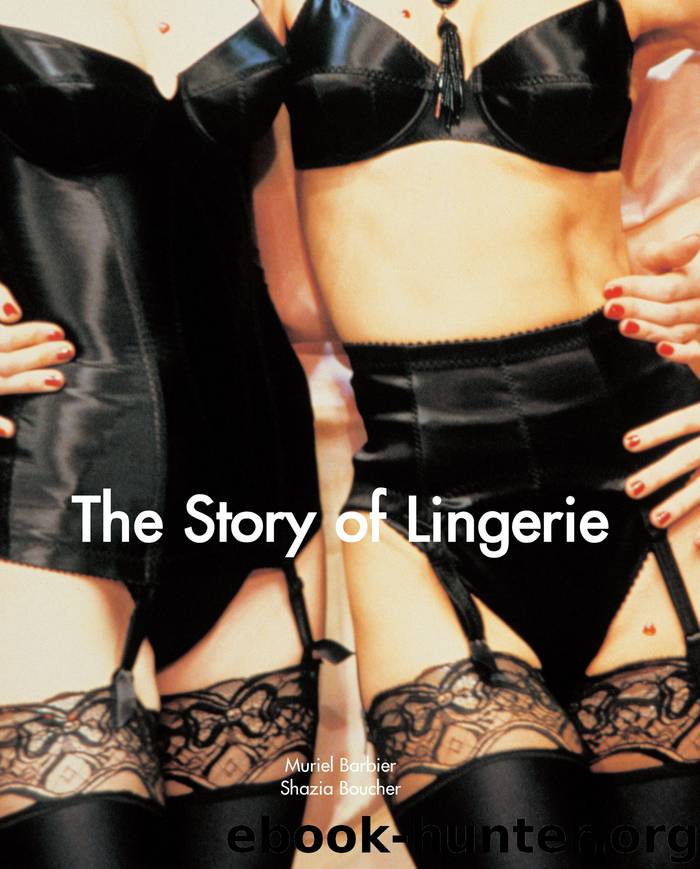The Story of Lingerie by Barbier Muriel; Boucher Shazia;

Author:Barbier, Muriel; Boucher, Shazia; [Muriel Barbier, Shazia Boucher]
Language: eng
Format: epub
ISBN: 9781783107452
Publisher: Parkstone International
Anonymous, Photograph for the Diana Slip, c. 1935.
Silver print, 16 x 10 cm. Private collection.
Anonymous, Photograph, Private collection, Paris.
Although bloomers were acceptable in the 16th century, it was difficult for them to remain so during the following centuries. They were considered indecent due to the way they accentuated the anatomy. In the 18th century, bloomers were reserved for dancers and actresses so that their “assets” would not be revealed on stage as a result of a spin or a fall. This stage costume was not worn by any other women. Dutch skaters adopted bloomers at the end of the 18th century for the same reasons as the dancers and actresses, as well as for domestic chores such as climbing a ladder or cleaning windows. In England, little girls and young girls started wearing bloomers for gymnastics. Women who went hunting became progressively interested in bloomers for reasons of hygiene. But the bourgeoisie still associated this undergarment with dancers’ underwear and judged it shameless. Wearing bloomers was very quickly relegated to young girls for gymnastics, to little girls and…to prostitutes. Bloomers went hand in hand with freedom of movement for the body and were, of course, extremely erotic. Nevertheless, in the 1830s bloomers began to take hold once more. The introduction of the crinoline, which held skirts far from the body, meant that bloomers became necessary for reasons of modesty. This under-garment was thought to be extremely sexy in the cabarets that existed at the time of the French can-can. The Moulin Rouge was famous for its dancers who showed off their bloomers, as remembered in Henri Toulouse Lautrec’s paintings. Of course, as bloomers had become the trademark of scandalous dancers for the bourgeoisie (who did, in fact, enjoy the shows) and were the closest garment to a woman’s body, they were all the more attractive and disturbing to many men. Marcel Prevost humorously refers to the impact of bloomers on the male imagination (though in a particular, caustic context): “[…] The poor priest and his pupils were rooted to the spot by the unexpected show. In the bright sunlight over two hundred pairs of young girls’ bloomers were hung out, doubtless the last wash for the convent, and they swung gently, blocking the way. They were hung up by the waistband and so the breeze blew out legs and belly, swinging them back and forth, forwards and backwards, opening and then closing their openings, through which the blue sky could be seen. Sometimes a stronger gust of wind blew against the white washing line and the bloomers shuddered with their legs in the air as if they were trying to get back to their arrangement on the washing line…The bloomers were truly animated and provocative, independent and suggestive …[73]“
At the end of the 19th century, bloomers were displayed intentionally during dances such as the can-can and the “chahut” and also on the saucy postcards of the 1890s and the beginning of the 20th century. These showed women displaying elaborate bloomers which enlarged their hips and buttocks.
Download
This site does not store any files on its server. We only index and link to content provided by other sites. Please contact the content providers to delete copyright contents if any and email us, we'll remove relevant links or contents immediately.
Shoot Sexy by Ryan Armbrust(17557)
Portrait Mastery in Black & White: Learn the Signature Style of a Legendary Photographer by Tim Kelly(16872)
Adobe Camera Raw For Digital Photographers Only by Rob Sheppard(16797)
Photographically Speaking: A Deeper Look at Creating Stronger Images (Eva Spring's Library) by David duChemin(16498)
Bombshells: Glamour Girls of a Lifetime by Sullivan Steve(13685)
Art Nude Photography Explained: How to Photograph and Understand Great Art Nude Images by Simon Walden(12852)
Perfect Rhythm by Jae(5072)
Pillow Thoughts by Courtney Peppernell(4011)
The Book of Joy by Dalai Lama(3698)
Good by S. Walden(3347)
The Pixar Touch by David A. Price(3210)
A Dictionary of Sociology by Unknown(2854)
Fantastic Beasts: The Crimes of Grindelwald by J. K. Rowling(2843)
Humans of New York by Brandon Stanton(2687)
Stacked Decks by The Rotenberg Collection(2687)
Read This If You Want to Take Great Photographs by Carroll Henry(2602)
On Photography by Susan Sontag(2482)
Photographic Guide to the Birds of Indonesia by Strange Morten;(2407)
Insomniac City by Bill Hayes(2396)
